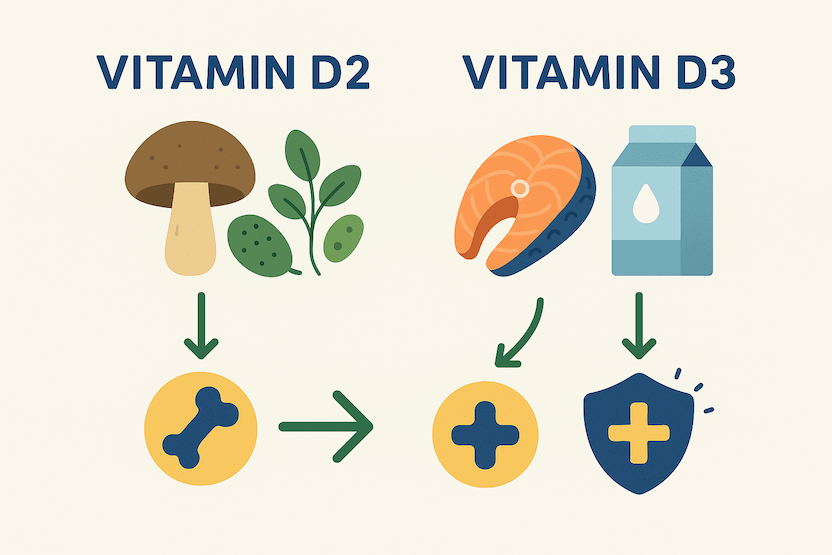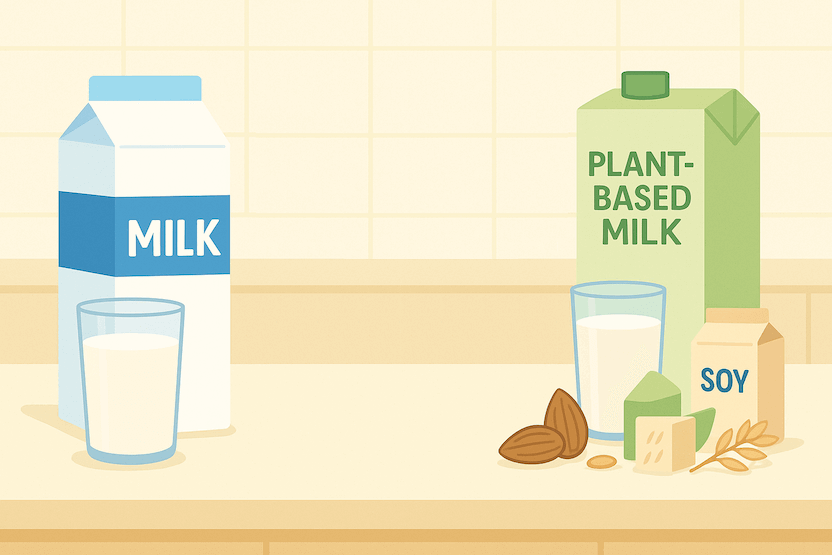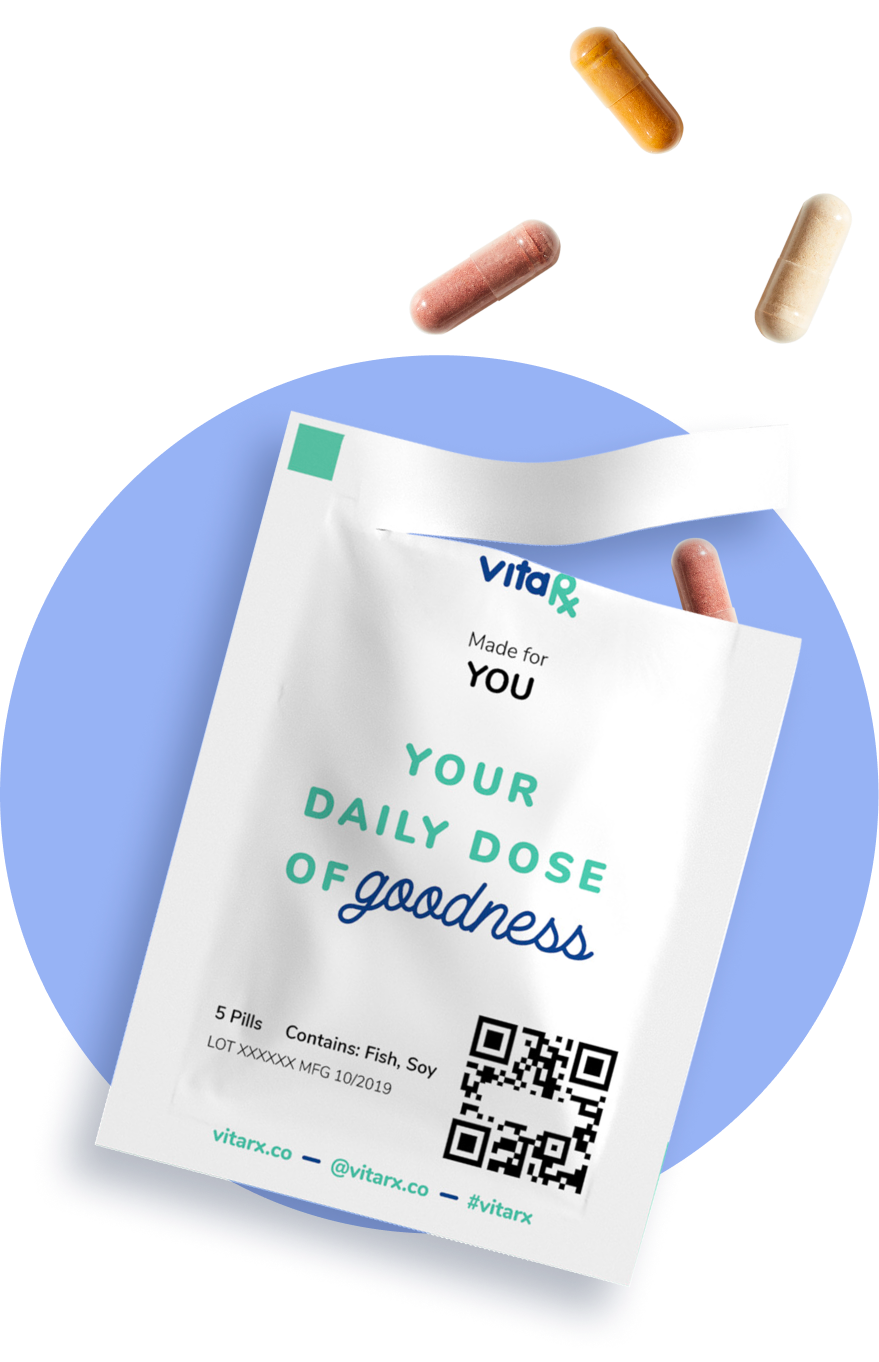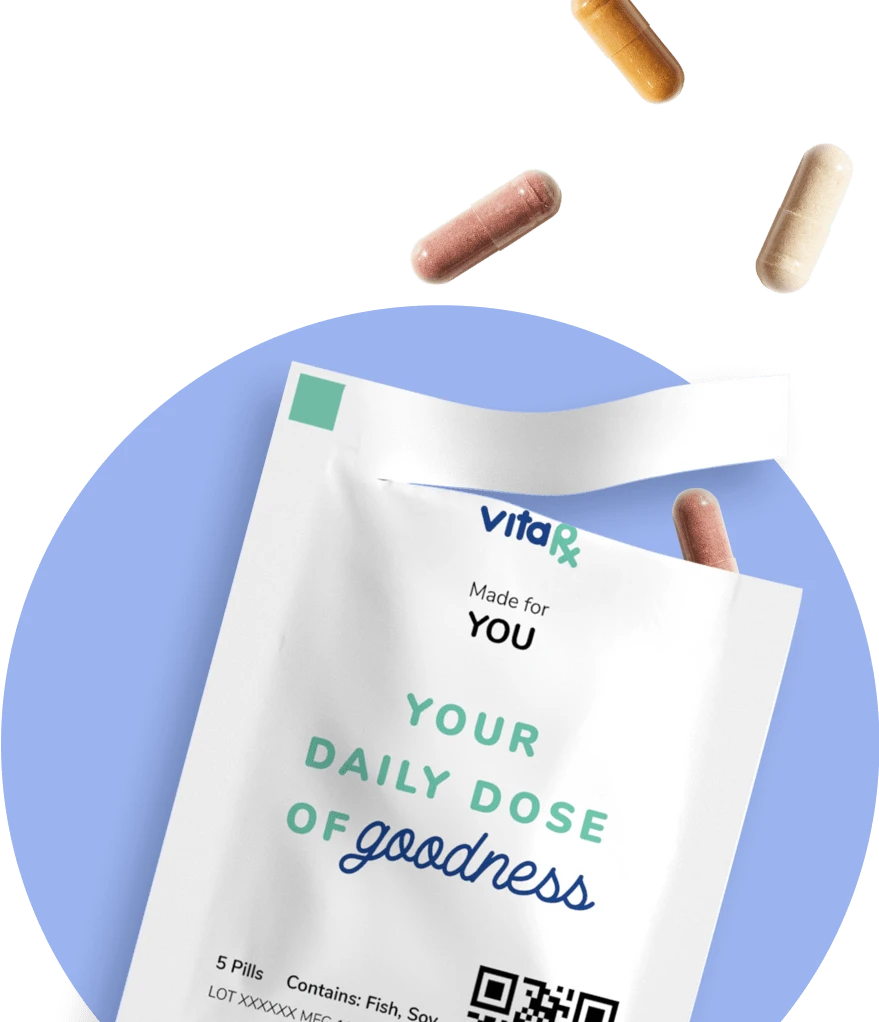Last update: July 2, 2025
6 minute read
Vitamin D2 vs D3: Which Is Better for Bone Health and Immune Support?
Explore the main differences between Vitamin D2 and D3, their sources, benefits, and discover which form your body prefers for the best health.

By Derick Rodriguez, Associate Editor
Edited by Dr. Dimitar Marinov, MD, RDN, PhD

Ever stood puzzled in the supplement aisle, wondering why there's a D2 and a D3—and what in the world sets them apart?
You're not alone—an estimated one-third to one-half of adults worldwide have suboptimal vitamin D levels, an essential nutrient linked to everything from bone strength and calcium absorption. It also affects your body's natural immune defense and much more!
Key takeaways
- Vitamin D3 typically offers higher absorption and sustainability of serum vitamin D levels than Vitamin D2
- Vitamin D2 is sourced from plants and fungi, making it a common and still effective option for vegans
- For most people, Vitamin D3 supplementation is often the better choice based on how well your body can use it
Vitamin D2 vs D3: What’s the real difference?
When browsing the supplement aisle, you may notice two types of vitamin D: D2 and D3. You might wonder, what’s the difference, and which one is better for your health?
Let’s start with their basic definitions. Vitamin D is an essential nutrient that supports bone health, muscle function, and immune system performance.
Both D2 (ergocalciferol) and D3 (cholecalciferol) are forms of vitamin D, but they come from different sources and have slight differences in how they’re processed by your body.

Vitamin D2 is mainly found in plant foods and fortified foods, whereas D3 comes from animal-based foods and is also made by the skin when exposed to sunlight.
Sources of vitamin D2 and D3
Here’s how you can get each type of vitamin D in your diet:
Vitamin Type | Food Sources |
|---|---|
D2 | Mushrooms (only if UV-exposed), fortified foods like cereal and plant-based milk, yeast |
D3 | Oily fish, egg yolks, fortified cheese, liver, butter, and from your skin via sunlight exposure |
Now that we’ve covered food sources, you might also be wondering: how much vitamin D can you really get from food vs. sunlight?
Most people only get small amounts from food; sunlight is the most important natural source for D3, but this can vary greatly by season and skin exposure.
How does your body use D2 vs D3?
Let’s see what happens after you eat a supplement for each form.
Both D2 and D3 are absorbed in the small intestine and changed in the liver and kidneys to the active form of vitamin D that your body can use. Both forms help your body absorb calcium, which is important for strong bones.
Still wondering about “the active form”? Your body turns both D2 and D3 into 25-hydroxyvitamin D (25(OH)D), the marker doctors check to determine your vitamin D status, and then into calcitriol, the active hormone.
However, recent research suggests that D3 is more effective than D2 at raising and keeping overall vitamin D levels in your blood.
A meta-analysis of randomized controlled trials showed that vitamin D3 supplementation raises blood 25-hydroxyvitamin D levels more effectively compared to vitamin D2—and this matters because higher, stable vitamin D levels are linked to better bone strength and immune health. D3 may be more reliable for ongoing needs.
Comparison table: D2 vs D3
Before exploring practical supplementation, let’s compare their key features.
Comparison Aspect | Vitamin D2 | Vitamin D3 |
|---|---|---|
Source | Plant-based (UV-exposed yeast, mushrooms), fortified foods | Animal-based (fatty fish, liver, eggs), sunlight |
Efficacy | Raises blood levels, but less efficient long-term | More effective in raising and keeping blood levels |
Dosage in Supplements | Commonly prescribed for high-dose therapy | Often preferred for over-the-counter supplements |
VitaRx Tip
Vitamin D3 is often made commercially by exposing cholesterol in sheep’s wool (lanolin) to UV rays.
Why is D2 sometimes used for prescriptions if D3 is more effective? D2 is historically used in pharmaceutical high-dose treatments and is vegan-friendly, which makes it better in specific cases.
Daily vitamin D requirements
Now, let’s cover how much vitamin D you actually need. Here’s a quick reference to the Recommended Dietary Allowance (RDA) (covers food + supplements):
Age Group | RDA (mcg) | RDA (IU) |
|---|---|---|
Infants 0–12 months | 10 | 400 |
Children and adolescents 1–18 years | 15 | 600 |
Adults 19–70 years | 15 | 600 |
Adults >70 years | 20 | 800 |
But wait—does recommended intake change depending on whether you use D2 or D3? No matter the type, the RDA covers total vitamin D intake from both dietary and supplemental sources.
While you can get some vitamin D from foods, few foods contain high levels naturally. This is why:
- People with darker skin absorb less D3 from sunlight.
- If you live far from the equator, your seasonal sunlight is limited.
- Wearing sunscreen regularly can lower your skin's vitamin D3 production.
— Dr. Dimitar Marinov, MD, RDN, PhDWhile both forms aid vitamin D levels, Vitamin D3, from animal sources and sunlight, is generally more effective at raising and sustaining blood levels than Vitamin D2 (plant-based). For optimal bone and immune health, D3 is often preferred, but D2 remains a vital option for vegans and in specific therapeutic cases.
Vitamin D deficiency: Signs and solutions
Let’s check what happens if you’re running low—and what you can do next.
Vitamin D deficiency can lead to weakened bones, muscle weakness, and in severe cases, rickets in children or osteomalacia in adults.

If you think you might be low on vitamin D, talk to your doctor, who may recommend a supplement. D3 is usually preferred for supplementation because it stays in your body longer and raises blood levels more efficiently. D3 sticks around longer in your system, so your vitamin D levels won’t fall as quickly between doses.
Food sources of vitamin D2 and D3
Let’s break down actual food sources side by side.
Food Source | Vitamin D2 (mcg) | Vitamin D3 (mcg) |
|---|---|---|
Cod liver oil (1 Tbsp) | - | 34 |
Trout (3 oz) | - | 16.2 |
Salmon (3 oz) | - | 14.2 |
Sardines (2 pieces) | - | 1.2 |
Eggs (1 large) | - | 1.1 |
Beef liver (3 oz) | - | 1 |
Mushrooms (UV-exposed, ½ cup) | 9.6 | - |
Fortified dairy and cereals | Varies | Varies |
Still curious about added nutrients? Most U.S. Cow’s milk is supplemented with D3, while plant-based milks and cereals often use D2, making label reading important if you avoid animal products.

Should you supplement with D2 or D3?
Now for the big question on supplements.
We can meet our vitamin D needs with either form, but vitamin D3 is generally preferred because it’s more effective at keeping those levels over time. Vitamin D2 supplements still remain effective, especially in treating deficiency, and may be prescribed at high doses.
Wondering which is best for vegans? D2 is plant-based and vegan, while most D3 is animal-derived; however, vegan-friendly D3 supplements made from lichen are now available. Sunlight can be surprisingly potent.
Sunlight helps with vitamin D
Estimates suggest that full-body exposure to strong midday summer sun can generate up to 10,000 IU of vitamin D3 in fair-skinned individuals; shorter or partial-body exposures generally produce much less, and the amount varies widely with skin tone, latitude, season, genetics, and age.
Frequently asked questions (FAQ)
Here are some of the most frequently asked questions about vitamin D2 and D3.
Final thoughts
Vitamin D2 and D3 might seem similar at a glance, yet they're very different when it comes to their origin, use, and how long they last in your system. Vitamin D3 clearly comes out ahead, offering better efficiency in raising and keeping vitamin D blood levels, especially for ongoing supplementation.
But remember: choosing between D2 and D3 can also depend on your dietary choices or specific health needs. If you're vegan, D2—or even vegan-friendly D3 sourced from lichen—could be your best bet.
Think for a moment: Are you meeting your daily vitamin D needs effectively, or is it time for a focused adjustment in your supplementation plan? Better yet, discuss your vitamin D status with your healthcare provider to see the best solution for your unique health situation.
Sources and references
Editor

Derick Rodriguez
Derick Rodriguez focuses on editing health and wellness-related content. With over half a decade of experience in the digital realm, Derick has developed a unique skill set that bridges the gap between complex health concepts and accessible, user-friendly communication. His approach is deeply rooted in leveraging personal experiences and insights to illuminate the nuances of health and wellness topics, making them more approachable and empowering readers with knowledge and confidence.
Fact checker

Dr. Dimitar Marinov
Dr. Marinov has years of experience in scientific research and preventive and clinical medicine. His publications in peer-reviewed journals are on nutritional status, physical activity, and musculoskeletal disorders among adolescents.
At VitaRx, we're not just passionate about our work — we take immense pride in it. Our dedicated team of writers diligently follows strict editorial standards, ensuring that every piece of content we publish is accurate, current, and highly valuable. We don't just strive for quality; we aim for excellence.
Related posts
While you're at it, here are some other relevant articles you might be interested in.

Get your personalized vitamin recommendations in less than
5 minutes.
Get your personalized vitamin recommendations in less than
5 minutes.






